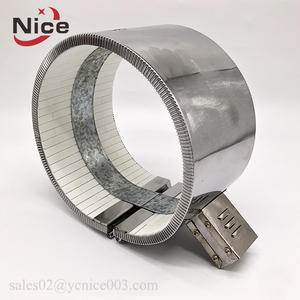
All categories
Featured selections
Trade Assurance
Buyer Central
Help Center
Get the app
Become a supplier

(994 products available)



























An induction process heater is a machine that heats metals using inductive heating, a process that generates heat through electromagnetic induction. Induction heaters work by creating heat through an electric current that flows through coils placed around the metal. The coils create a magnetic field that induces multiple small electrical currents in the metal. Induction heaters have many benefits, and their designs are often compact, reducing the space they use within a production line.
Induction process heaters are used in multiple industries and can serve a wide range of applications. Generally, heaters can be induction hardening machines, heating and melting furnaces, or specialized machines to heat metals before forging or rolling them into sheets. More detailed classifications include the following:
Induction Hardening Heaters:
Induction hardening heaters are mostly used in the metalworking industry to selectively case harden metals. Hardening means that metals are made harder by altering their molecular structure when heated. The case in induction hardening refers to the outer layer of the metal. Selectively hardening metals is beneficial when a metal needs to retain a soft inner layer for better toughness while having a hard exterior for superior abrasion resistance.
Induction Melting Heaters:
Induction melting heaters can heat metals at high temperatures until they reach their melting point. Depending on the specifications of an induction heater, it can reach temperatures exceeding 1700°C. Induction melting heats are commonly used in foundries and can melt metals like steel, iron, gold, aluminum, copper, etc.
Induction Preheating Process Heaters:
Induction preheating process heaters heat metals to a specified temperature before a secondary manufacturing process takes place. They are commonly used to soften metals before machining and increase the temperature of metals before welding.
Following are the specifications of the induction heater and their maintenance.
Induction heaters require maintenance mainly on the cooling system.
Induction heaters are essential equipment to help heat various products made of ferrous, non-ferrous, and magnetic materials. Below are some of the typical applications of induction heaters in different industries:
When buying induction process heaters, it's essential to evaluate the suppliers thoroughly to ensure their products will benefit the end-users. Check if the manufacturer provides customization services. This is important as it allows the distinct needs of various industries and applications to be fulfilled. The supplier should be open to tailoring the size, capacity, voltage, frequency, and heating coils of the induction heater to suit specific requirements.
Consider the advisability of portable induction process heaters for sale that are easy to transfer from one workstation to another as well as lightweight induction heaters that don't take up too much space. Induction process heaters with remote monitoring capabilities allow users to monitor their performance from a distance, thus enabling condition-based maintenance. Induction heaters with self-diagnosis and safety features assist operators in identifying potential issues and prevent accidents and hazards, thereby promoting a safer working environment. These process heaters should be easy to install and require minimal maintenance so that downtime can be reduced.
Check the warranty on the product, as it shows the manufacturer's confidence in their product. A longer warranty period indicates that the manufacturer believes in the durability and reliability of their induction heaters. This provides the buyer with additional reassurance. Pay attention to the power output of the induction heater. Different processes and applications require distinct levels of power output. Ensure the final choice can meet specific heating needs efficiently. Also, assess the overall energy efficiency of the induction heater. Selecting a heater that is more energy efficient not only reduces operational costs but also contributes to the sustainability goals of businesses.
Finally, consider how the induction process heater complies with international standards and certifications. This ensures that the products are safe, reliable, and of high quality. It's also essential to consider the variety of heating coils that induction heaters offer. Ensure that the induction coils available can cater to specific applications and processes.
Q1: What is the working principle of induction heating process?
A1: Induction heating works by electromagnetic induction. The process heats metal components through the coils that generate a heat source. The metal will be heated up when an electric current is passing through the coil, creating a magnetic field that induces an electric current in the metal object.
Q2: What are the parts of an induction heater?
A2: An induction heater consists of an induction coil, a power supply, and the metal workpiece. The induction coil is usually in a circular shape or made into other shapes to fit various objects. The power supply provides the electric current, which may come from direct current (DC) power, an AC power, or other sources.
Q3: What are the application areas of industrial induction heaters?
A3: Industrial induction heaters are commonly used in the machinery manufacturing industry. They are also used in automotive, aerospace, metal fabrication, and other industries. Induction heaters can perform various heating processes such as hardening, tempering, brazing, annealing, and melting.
Q4: What are the advantages of using induction process heaters?
A4: Induction process heaters have many benefits. They heat up quickly, and the heating is precise and evenly distributed. Induction process heaters are also safe to use because they do not have an open flame, and the heating is localized, reducing the risk of fire. Additionally, induction heaters are environmentally friendly because they do not produce emissions.